With the advancements in digital technology, solid-state and modeling amplifiers have come a long over the past decade or so. This has had a particularly noticeable impact on small battery powered guitar amps as the market is flush with incredible options.
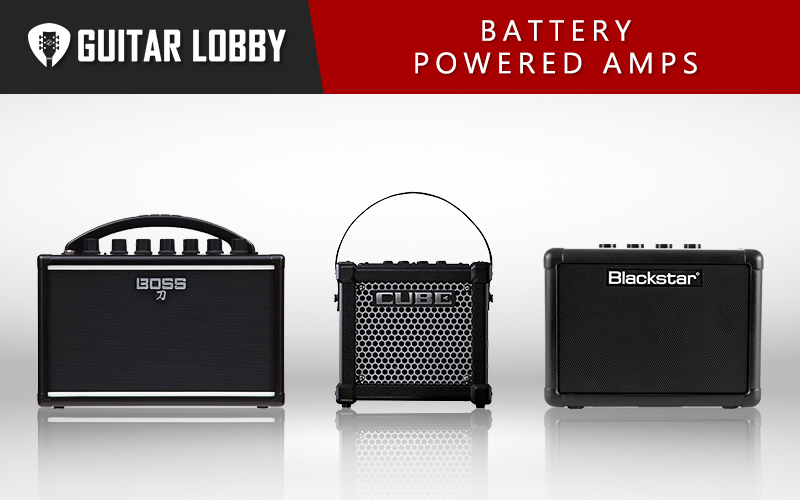
The biggest selling point of these battery powered amps is the fact that they are compact and sound great even at lower volumes. They are specifically designed to give you a great sound even while playing at lower volumes which is perfect for desktop practicing or for those living in apartments or townhouses where you share walls with neighbors.
I’ll start this article by reviewing the best battery powered guitar amps at each price point, but if you want to learn more about them before reading reviews, check out our buying guide at the bottom of the page.
| Name of Product | Image of Product | Description | Price Range | Full Review |
|---|---|---|---|---|
| 1. Yamaha THR30ii (Best Overall) | 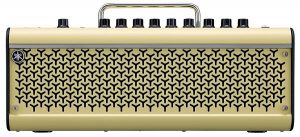 | Type: Solid State Power: 30W (2 x 15W stereo), 15W (battery) | $500 | Read Full Review Below |
| 2. Boss Katana Mini (Best Value) | 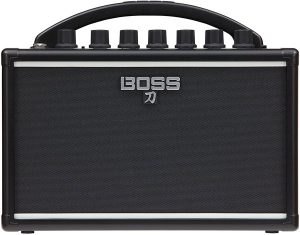 | Type: Solid State Power: 7W | $100 | Read Full Review Below |
| 3. Blackstar Fly3 (Budget Pick) | 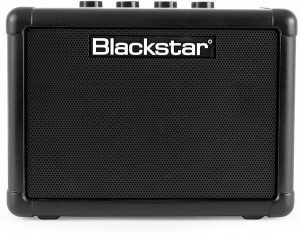 | Type: Solid State Power: 3W | $70 | Read Full Review Below |
| 4. VOX Mini-3 G2CL (Editor's Choice) | 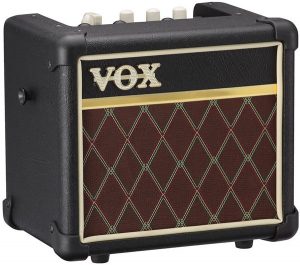 | Type: Solid State Power: 3W | $150 | Read Full Review Below |
| 5. Roland AC-33 (Best for Acoustic Guitars) | 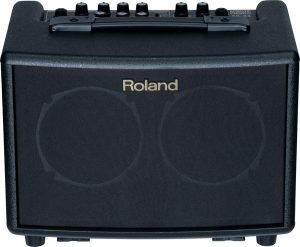 | Type: Acoustic Amp (15w+15W) Power: 30W | $500 | Read Full Review Below |
| 6. Yamaha THR5A (Best Value for Acoustic Guitars) | 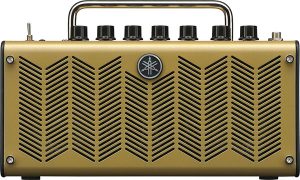 | Type: Solid State Power: 10W | $200 | Read Full Review Below |
| 7. Danelectro Honeytone Mini | 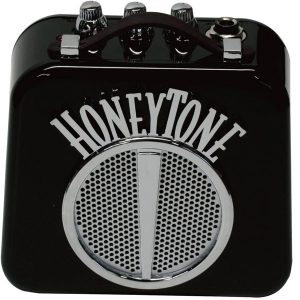 | Type: Solid State Power: 1.5W | $22 | Read Full Review Below |
| 8. Fender Tonemaster Mini | 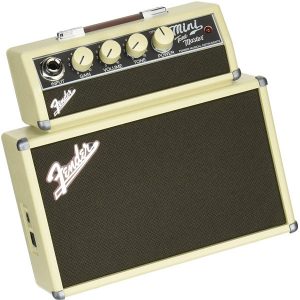 | Type: Solid State Power: 1W | $50 | Read Full Review Below |
| 9. VOX amPlug AC30 | 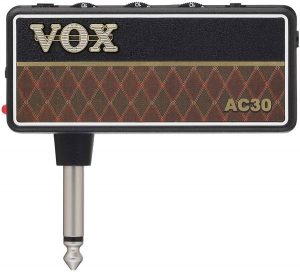 | Type: Solid State Power: 1W | $41 | Read Full Review Below |
| 10. Marshall MS-2 | 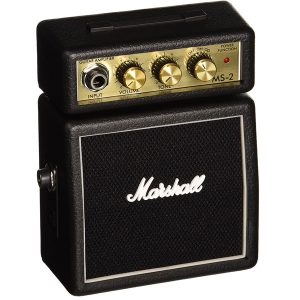 | Type: Solid State Power: 1W | $55 | Read Full Review Below |
| 11. Orange Microcrush Pix3 | 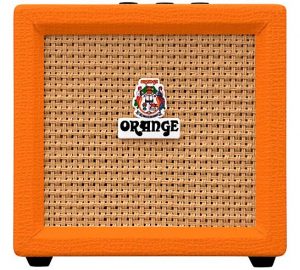 | Type: Solid State Power: 3W | $70 | Read Full Review Below |
| 12. Fender Mini Deluxe | 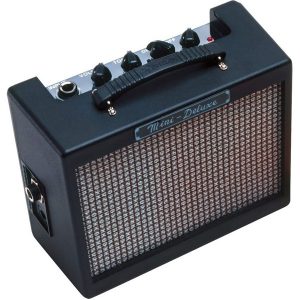 | Type: Solid State Power: 1W | $34 | Read Full Review Below |
| 13. Roland Micro Cube GX | 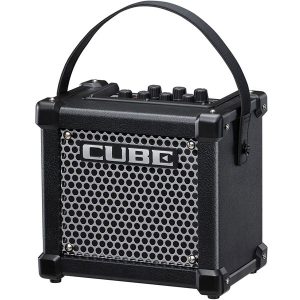 | Type: Solid State Power: 3W | $160 | Read Full Review Below |
| 14. Pignose HOG-30 Best for Bass | 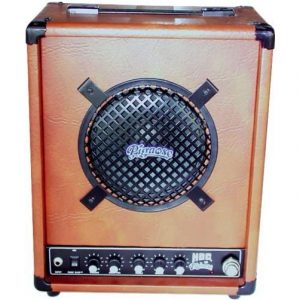 | Type: Solid State Power: 30W | $270 | Read Full Review Below |
| 15. Roland Cube Street- Best Busking Amp | 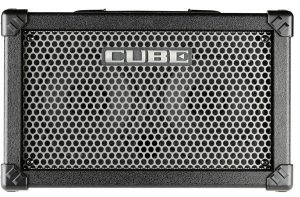 | Type: Solid State Power: 5W | $300 | Read Full Review Below |
Here Are the Best Battery Powered Guitar Amps
1. Yamaha THR30ii (Best Overall)
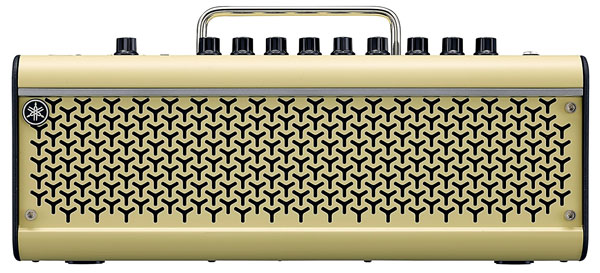
| Estimated Price | $500 |
| Type | Solid State |
| Power | 30W (2 x 15W stereo), 15W (battery) |
| Speaker Size | 2 x 3.5” |
| Effects | Chorus, Flanger, Phaser, Tremolo, Echo, THR Remote, Compressor, Noise Gate |
| EQ | 3-Band |
| Inputs | 1 x 1/4″, 1 x 1/8″ (aux in) |
| Headphones | 1 x 1/8″ |
| Power Source | Internal Rechargeable Battery and Included 15V DC Power Supply |
My Review: The THR30ii started its life in 2011 with the original design, the THR10 amplifier, being called the ‘Third’ amp. This amp was not intended to be a large valve amp for gigging or a smaller combo amp for recording. The THR10 was meant to be entirely different, and a desktop modeling amp built for home use, where players spent most of their time. While Yamaha pioneered this amp style, other companies followed suit and created their own versions of these desktop amps. For Yamaha to keep up in this market, they needed to step up their game to keep their amps relevant.
Yamaha decided to change up the design of the THR30ii, allowing it to sit on a bookshelf or desk for easy access, making it more functional as well. It has a beautiful cream finish and is roughly the size of a four-slice toaster, making it compact enough to fit anywhere. The biggest upgrade on this amp is its reworked 3.5-inch full-range loudspeakers that enhance bass and stereo spread. The black molded plastic and cream steel are appealing and give this amp an elegant look, and much like the THR5A, this amp has the same LED glow behind the grill, adding to the elegance. Something nice that Yamaha added to the THR30ii is that the LED colors on the control panel change depending on which of the three modes you are using- Red for ‘classic,’ Green for ‘Modern,’ and blue for boutique.
These controls are almost identical to the THR5A, putting a standard gain, volume, bass, mid, and treble. Two additional controls on the panel operate the effects. One operates the chorus, tremolo, phaser, flanger, and four options with echo and reverb; echo, echo/reverb, hall reverb, and spring reverb. The reverb and tremolo stand out with the extended stereo technology on this amp. The depth you get out of this amp would not be something you expect from an amp this small. You will find a pair of stereo line outs at the back of the amp, which connect to balanced or unbalanced jack plug leads, together with a USB socket and a power socket for the THR30iis laptop-style power supply. The biggest drawback that this amp has is its battery life. With an internal rechargeable battery in the THR30ii, it only has a measly five-hour battery life making it nowhere near as useful as some of the competition it is going up against.
Let us talk about how it sounds; the THR30ii has excellent response and certainly feels valve-like. The amp itself produces rich low end and sparkling highs without any compromise. With an extremely sensitive EQ, you have the ability to change the shape of your tone quickly. Touch sensitivity is a term banded around a lot, but it matters a great deal with modeling amps. Giving players the feeling that they are playing a tube amp, they will keep you coming back.
The THR30iis 15W+15W output is fine for smaller gigs, and the line out PA can bring up your volume; and as I mentioned previously, the battery life is the real killer when It comes to making that decision. While this is a wonderful amp with superb tone and plenty of effects, it makes a better home practice amp if you only plan on running on battery life alone.
2. Boss Katana Mini (Best Value)
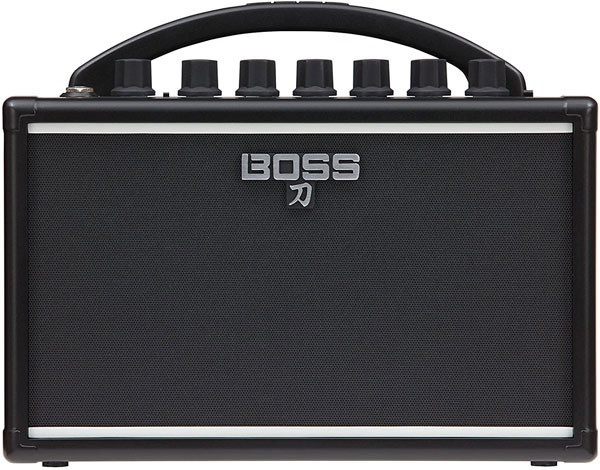
| Estimated Price | $100 |
| Type | Solid State |
| Power | 7W |
| Speaker Size | 1 x 4″ |
| Effects | Delay |
| EQ | 3-Band |
| Inputs | 1 x 1/4″ (instrument), 1 x 1/8″ (aux in) |
| Headphones | 1 x 1/8″ (headphones) |
| Power Source | 6 AAA Batteries |
My Review: The Boss Katana series is generally a well-received line of amps with their larger 100w amps that work wonders on stage or in the studio, but Boss decided to set their sights on something a little smaller. The Boss Katana mini is a small 7W portable combo amplifier that offers players a stellar performance in a much smaller package. The Katana Mini offers a variety of different onboard effects and amp models, allowing players to really dig in and find the exact sound they are looking for. The Katana Mini is the smallest amp in the Boss Katana line-up, coming in at a 7W amp section and a four-inch speaker. While the Katana mini might be small, it still has the same great sound that its bigger brothers deliver on a much smaller scale.
The Katana Mini uses the same multi-stage analog gain circuit that helps its three voice settings come to life. This amp comes equipped with a clean, crunch, and brown (high gain), along with a 3-band EQ and delay effect. Using this amp, I have noticed that it has a fantastic high gain sound that fits well if you play metal music or other more modern styles. Its mid-gain and delay are also greatly appreciated allowing for more options in tone. While this amp does not feed the desire for tone options that some players are looking for, I have noticed that the Mini is close if not on par with some of Boss’s larger Katana models.
While the amp itself sounds excellent, the biggest issue that others have come across is that the Mini does not put out enough volume for my liking compared to some of the other amps on this list. I have also noticed that at higher volumes, the amp does have a slight humming noise.
If you love high gain tones or the Katana model amps, this amp is a solid option for players looking for a great battery powered amp for home use or small venue playing. Even if this amp does not quite muster up the same kind of volume some of the other amps this list can, The Boss Katana Mini brings a lot to the table, making it a great choice for newbies and veterans alike. Overall, I would say that this is the best battery powered guitar amp for the money.
3. Blackstar Fly3 (Budget Pick)
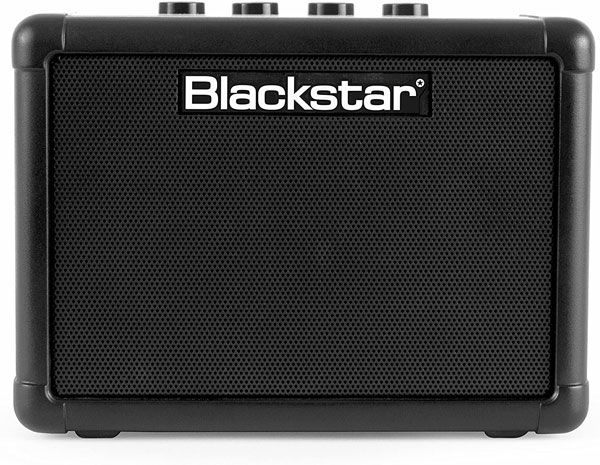
| Estimated Price | $70 |
| Type | Solid State |
| Power | 3W |
| Speaker Size | 1 x 3″ |
| Effects | Delay, Overdrive |
| EQ | 1 Band |
| Inputs | 1 x 1/8″ (emulated out/headphones), 1 x RJ45 jack (extension speaker) |
| Headphones | 1 x 1/4″ (instrument), 1 x 1/8″ (line-in) |
| Power Source | 6 AA Batteries or Optional Power Supply |
My Review: The Blackstar Fly 3 is a small battery powered amp created by one of the best amp manufacturers in the business. While Blackstar is more well known for their larger amp models, such as the Studio 10 series or the Silverline Standard series. Much like Boss, Blackstar wanted to make an amp on a much smaller scale—making an amp as portable as possible for players to bring their amp anywhere. Without the hassle that comes along with larger amps gives players the ability to practice anywhere and everywhere.
In comes the Blackstar Fly 3 with a 3W, three-inch speaker; this small amp packs a massive punch. Out of the box, I noticed that the build quality of the amp itself is fantastic. Normally with these small battery powered amps, you notice that they have sub-par build quality. Usually, these amps feel very flimsy and more like toys. While in most cases, these amps are typically used to practice and mess around, not used for serious sound. The Fly 3 breaks that mold; even though it was made of plastic, the Fly 3 three has surprising weight, giving it the feel of a real full-size amp, including a small metal grill over the speaker.
The next big question is, “But how does it sound?” and my answer would be fantastic. The Fly 3 offers a thick and rich overdrive while the OD switch is on, or you can bring it down with the switch is off, giving clear, clean tones. While Fly 3 only has a 1-band EQ, it gives you a decent amount of control and enough options to create a different array of tones.
The Fly 3 offers a very simple 4-knob control system, with controls for gain, volume, EQ, and Delay. On the control panel, you also have options for overdrive and delay as well. These knobs all feel incredibly smooth and work well, with no real issues,
While the Fly 3 might be slightly more expensive than some of the other options on the market, what you are getting in return for that price difference makes up for it. The Fly 3 is one of the best battery powered amps on the market, in my opinion, offering fantastic tone quality, simple controls, and great build quality. If you are in the market for a great amp, the Fly 3 is worth a look.
4. VOX Mini-3 G2CL (Editor’s Choice)
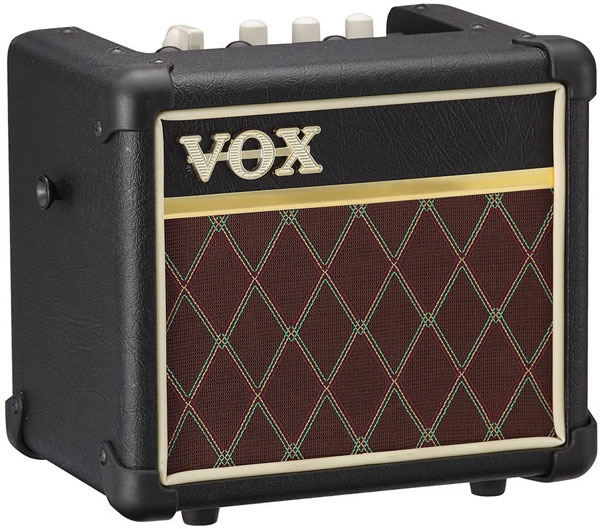
| Estimated Price | $150 |
| Type | Solid State |
| Power | 3W |
| Speaker Size | 1 x 5″ |
| Effects | Compressor, chorus, flanger, tremolo, delay, and reverb |
| EQ | 2-Band |
| Inputs | 1 x ¼” (Instrument), 1 x 1/4″ (Mic), 1 x 1/8″ (Aux) |
| Headphones | 1 x 1/8″ |
| Power Source | 6 AAA Batteries or included AC adapter |
My Review: The small yet mighty Vox MINI3 G2 is a great small battery powered guitar amp that gives players a great portable amp. This amp gives players quite a bit of control over their sound with its dual-band EQ and a handful of different effect options that allow players to fit into any genre they find themselves playing in. The amp has the “Bassilator” circuit, which gives players some perceived bottom end to the sound, making it sound much louder than it is. It shares the same DNA as VOX’s Valvetronix series modeling amplifiers with 11 built-in amp models and eight effects.
With a single 5″ speaker, an overall size of 10.3″ x 6.9″ x 8.8″, and weighing only 6.6lbs, it’s obvious that portability is the name of the game here. No, it will not fit in your coat pocket, but it’s certainly small enough to carry around. It comes with a 1/4″ mic input and has an auxiliary so you can jam to your favorite tunes through the amp or headphones. There is also a guitar tuner onboard. As is fitting with an amp of this size, the controls are fairly simple and intuitive, although very extensive. No menus to scroll through or tons of buttons to press.
Each of the 11 amp models can be selected with a single rotary switch. The effects are broken up into two different control knobs: one for compression, chorus, flanger, tremolo, and another for the analog delay, tape echo, spring reverb, and room reverb.
You may assume that such a small amp would not be able to deliver. Sometimes you may be right, but you could not be further from the truth on this occasion. The overall tone is rich and full, and it is certainly loud enough to fill a room. The only real issue I found with this is that the amp does not have the greatest tone quality at higher volumes. Due to circuit headroom limitations, the amp does not have the power to keep up with the sound you are trying to put out.
With its battery life of just over 10 hours, it makes a great practice companion and even works well for small gigs. With 11 different modeling options ranging from clean tones to classic vintage tones, not to mention many essential effects that will allow you to find the exact sound you are looking for. All in all, the Vox Mini-3 G2CL is a battery powered amp that can fit the part in any given situation.
5. Roland AC-33 (Best for Acoustic Guitars)
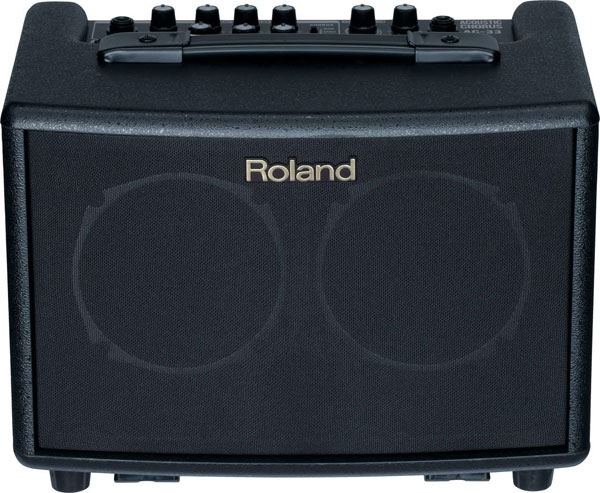
| Estimated Price | $500 |
| Type | Acoustic Amp (15w+15W) |
| Power | 30W |
| Speaker Size | 2 x 5″ |
| Effects | Chorus Reverb |
| EQ | Ch 1: 3-band; Ch 2: 2-band |
| Inputs | 2 x 1/4″, 1 x XLR, 2 x RCA, 1 x 1/8″ (aux) |
| Headphones | 1 x 1/4″ |
| Power Source | 8 AA Batteries or included AC Adapter |
My Review: Another entry from Roland at a higher price point, the AC-33, is a highly rated acoustic chorus guitar amplifier that is portable yet powerful. Much like the THR5A by Yamaha, the AC-33 is created specifically with acoustic guitars in mind. The AC-33 is equipped with Roland’s latest DSP technology, offering pure, rich acoustic tones and great projection far beyond its size. The AC-33 offers a true stereo design with two 15w speakers, giving it a brilliant stereo multi-band chorus.
The Ac-33 also includes a phase looper setting that allows you to record, loop, and play over your riffs and even allows you to play over incoming audio from the AUX input. With this function, you can record a 40-second loop to play over. This feature makes street performing much more interesting.
The AC-33 has an incredible sound, but the only real issue with this amp is that it has a hard time projecting compared to some of the other battery powered amps on the market. The AC-33 would be more at home in a studio than on the street due to its lack of projection, which is a shame because it has an extremely sweet tone. For small gatherings, it would serve you well in performance.
6. Yamaha THR5A (Best Value for Acoustic Guitars)
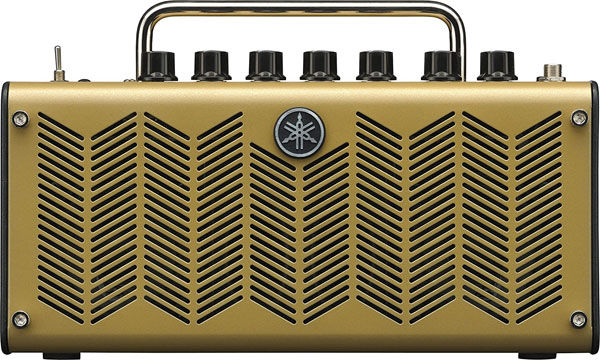
| Estimated Price | $200 |
| Type | Solid State |
| Power | 10W |
| Speaker Size | 2 x 3″ |
| Effects | compression, chorus, flanger, phase shifter, tremolo, delay, reverb |
| EQ | 1-Band |
| Inputs | 1 x 1/4″, 1 x 1/8″ (Stereo) |
| Headphones | 1 x ¼” |
| Power Source | 8 AA Batteries or AC Adapter |
My Review: The Yamaha THR5A is a battery powered amp geared toward acoustic players. It is becoming more commonplace in the world of acoustic guitar performance, so it is no surprise that players would want a nice acoustic amp for home use. The THR5A gives players the chance to practice under similar conditions in which they perform, allowing players to use plenty of accessories, including loopers and effect pedals, or enjoy a larger sound for their acoustic guitar. Yamaha gave guitarists all of the larger than life power and sound quality that you would come to expect from a much larger PA system in an incredibly small package. While the THR series was originally created with electric guitars in mind, introducing the THR5A brings the concept to acoustic players broadening the horizons of many more players looking for a portable amp solution.
The THR5A is incredibly small, looking more like a lunch box than an amplifier. When I first saw this amp, I almost thought it was a head for a speaker cabinet, but it was all self-contained, with a pair of small three-inch speakers in the unit. The next surprise I got from this amp came in the form of a nice warm glow of tubes that slowly fades in. While these lights might be from LEDs, they look great and give the amp a premium look and feel. While looking at this amp, I had my reservations about such a small package’s sound quality. While the amp might not rival a full PA system or a larger high-powered amp, the sound and volume that came out of this amp filled the room from only two extremely small speakers.
The THR5A has inputs and controls line the top of the box, starting with the power switch, a ¼-inch input jack, stereo auxiliary input, and headphone output. A five-position switch allows you to select from different mic models, including Condenser, Dynamic, and Tube, as well as a Nylon setting and a Clean electric guitar mode. The amp has a confusingly named Master volume, which appears to be input gain (or channel volume), as well as a Volume control, which affects the overall output level. The effects controls are unusual in that they combine multiple effects in a single knob. For example, the DLY/Rev (delay/reverb) control is off when fully counter-clockwise, bringing in progressively louder delays when turned clockwise and gradually adding reverb. Turning the knob further moves to a hall reverb with no delay, starting with a low mix and adding more and more reverb as you continue to turn clockwise. The compressor/chorus knob acts similarly, with compression increasing as you turn the dial, changing into the chorus. While switching around, your effects on a dial might seem confusing at first, but you will get used to it the more you use it.
This amp has a ridiculous tone and volume for its size, and with its roughly 6-hour battery life on eight AA-Sized batteries, it makes it a no brainer for acoustic players.
Popular Related Article: Our Favorite Portable Guitar Amps
7. Danelectro Honeytone Mini
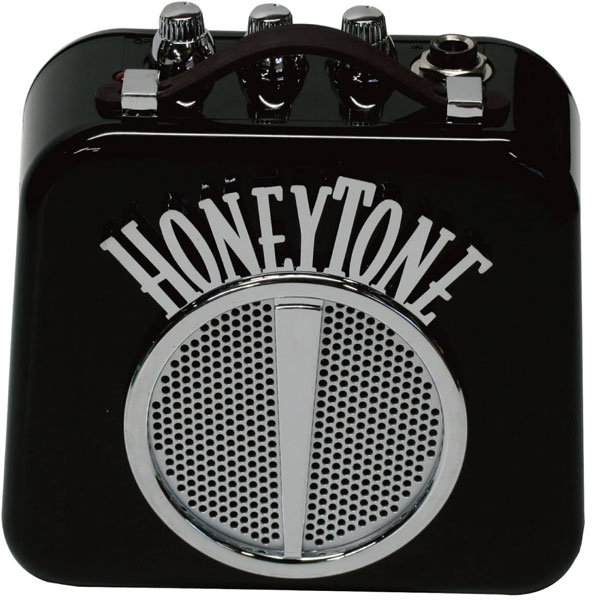
| Estimated Price | $22 |
| Type | Solid State |
| Power | 1.5W |
| Speaker Size | 1 x 2.5” |
| Effects | Overdrive |
| EQ | Tone Control |
| Inputs | 1 x ¼” |
| Headphones | 1 x 1/8″ |
| Power Source | 9V battery or 9V AC adapter |
My Review: The Danelectro Honeytone mini is way better than I expected, putting in quite a bit of work for such a small battery powered amp. At 1.5W and with one 2.5″ inch speaker, this battery powered amp is one of the smaller amps on this list but has great tones and an eye-catching retro look in three different colors. The Honeytone mini runs on a single 9V battery or a 9V adapter. The Honeytone mini offers incredible battery life on a single battery, and you can look forward to roughly 8 to 10 hours of life out of a single battery giving you plenty of time to jam before you have to swap the battery out.
This amp does offer two tonal knobs to adjust your bass and treble settings to ensure you have the best tone possible while playing. Speaking on different tonal options, the Honeytone mini also offers an overdrive switch to give you hotter bluestones, which helps if you are playing outside and pedals are not readily available. While the Honeytone mini might be small, it can put out quite a bit of sound, making it great for solo street performances or even in small acoustic performances. This amp has you covered. If you are looking at this for more of a practice amp, it also has you covered there. It has a 1/8″ headphone to allow you to comfortably use any standard headphones without having to go through a multitude of different adapters or buying a new set of headphones. As with all battery powered amps, portability is one of the biggest factors for me when it comes down to choosing the right amp. With the Honeytone mini, Danelectro made it insanely easy to carry around. The Honeytone mini comes equipped with an integrated clip to allow players to attach the amp to their belt and effortlessly carry it around it with them.
The Danelectro Honeytone Mini offers players a great-sounding amp with quite a few different tonal options, and at a price of only $22, you really cannot beat that.
8. Fender Tonemaster Mini
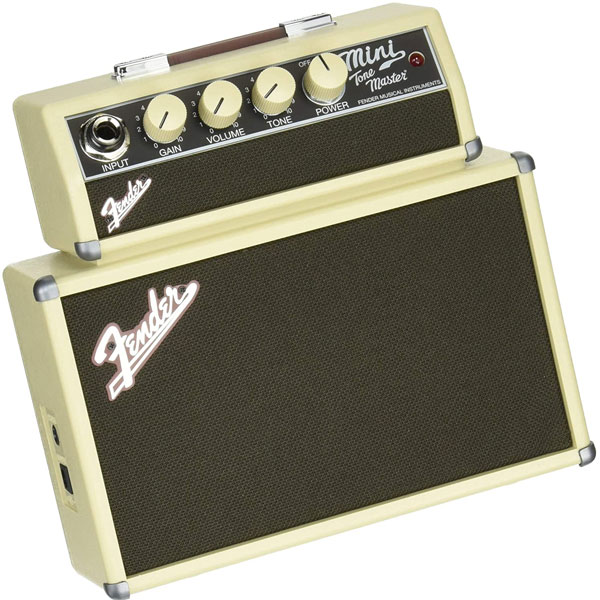
| Estimated Price | $50 |
| Type | Solid State |
| Power | 1W |
| Speaker Size | 2 x 2″ |
| EQ | 1-Band |
| Inputs | 1 x ¼” |
| Headphones | 1 x 1/8″ |
| Power Source | 9V Battery or 9V AC Adapter |
My Review: The Fender Tonemaster mini is miniaturized recreation of the classic Fender Tonemaster Twin Reverb amp giving it that vintage feel with that classic tone you have come to know and love from Fender but in a much smaller package. The look is a classic fender, with the amp’s bulk (including the speakers) housed at the bottom section. The equalizer presets are situated at the top. They will give you a good mix-up between clean or slightly distorted sounds that will sit well during practice or jamming sessions. Speaking of tone, the Tonemaster Mini offers a glorious tone for its small stature. The Tonemaster also has a clean sound that is free of skipping and other annoying imperfections.
The Tonemaster Mini has dedicated tone, volume, and gain controls giving players quite a bit of control over their tone for such a small amp. The volume and gain controls allow the speakers to be played at lower volumes, so you will not disturb others and still get some late night practicing. Fender also wanted to give players a much more common headphone jack to use headphones that use a 1/8″ jack instead of a ¼” jack that you see on bigger amps. No need for any complicated adapters for this making it very user-friendly. Like the Danelectro amp mentioned previously, the Fender Tonemaster Mini runs on a single 9V battery or a 9V AC adapter. From my own experience with this amp, I have noticed it gets roughly 10 to 12 hours of continuous usage.
The Fender Tonemaster Mini Is a small but might amp that gives players a great way to practice at a great price point. At under 50 dollars, the Tone master mini great investment for player wants to play anywhere and everywhere without sacrificing tone. The Tonemaster Mini is only about 1.1 pounds, so as long as you are not loaded with other equipment while walking, it should not become too much of a struggle to deal with. But this may also pose a potential problem when you are practicing in a group session. Because of the weight, it is extremely easy to move it around while plugged into a guitar. Regardless, the Fender Tonemaster Mini is great for the money as a practice amp or as a backup for your larger amps.
9. VOX amPlug AC30
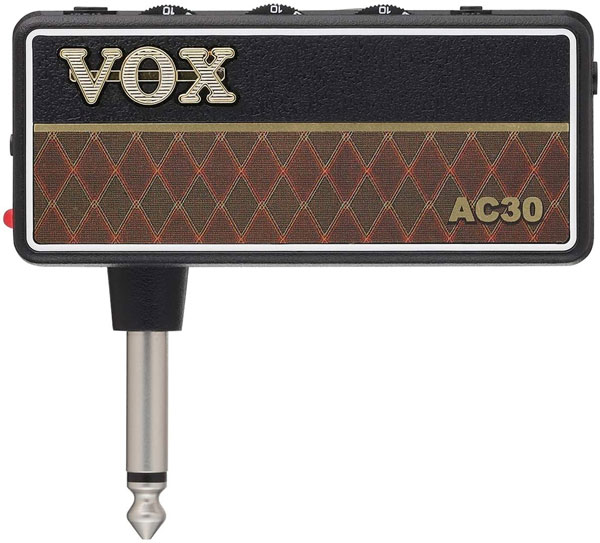
| Estimated Price | $41 |
| Type | Solid State |
| Power | 1W |
| Effects | Chorus, Delay, and Reverb |
| EQ | Volume, Gain, and FX control |
| Inputs | 1 x 1/4″ plug, 1 x 1/8″ (aux in) |
| Headphones | 1 x 1/8″ |
| Power Source | 2 AAA Batteries |
My Review: The Vox is the smallest amp on this list and surprisingly has some pretty great features compared to its size. The amPlug AC30 is known as a headphone amplifier, meaning that it is an extremely small portable amp that allows guitarists to plug their AC30 into their guitar and then connect headphones and get the same sound from a normal amp to your headphones.
With this compact amplifier in hand, you can practice anywhere in total silence; this is great when you are trying traveling or living in an apartment and trying to be conscious of the noise a full-size amp would create. That brings to the possible issues of the AC30. Being a headphone amp also means that it has no sound output other than to the headphones. Whether you are a beginner or advanced player, the AC30 still has some uses for each. As a beginner, this handy little device gives you the freedom to play and not interfere with anyone else you might live with, and you will not feel self-conscious because no one can hear you. As an advanced player, If you are working to improve or enhance your skills, the Vox amPlug amp allows you to play in silence, without forcing your housemates to listen to the same exercise a hundred times.
The AC30 features 100 percent analog circuitry, which means if you are not into digital modeling, the AC30 might not be for you. Although it is a small compact device, it has pretty great tonal qualities. The AC30 Runs on two triple AA Batteries Giving up to 10 hours of playtime before swapping them out.
Using the AC30 is very simple: plug the jack into your guitar, plug your headphones in, turn it on, and be ready to go. The power switch is located on the side and comes with two settings – ON and standby. Some models have an FX option, though. Three control knobs are available for controlling volume, gain, and tone. By tweaking these controls, you can get anything from a nice clean tone to medium distortion.
While the VOX amPlug AC30 is great as a practice amp, it is not much more than that. The Vox amPlug 2 AC30 is an ideal device for musicians who do not want to carry many accessories and make simple practice incredibly quick and easy. It makes it very easy to carry around, not needing any other cables or accessories. I feel like this amp is worth every cent.
10. Marshall MS-2
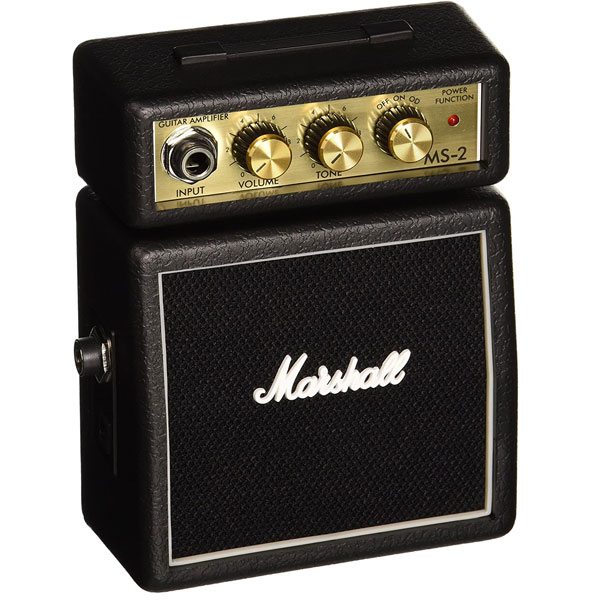
| Estimated Price | $55 |
| Type | Solid State |
| Power | 1W |
| Speaker Size | 1 x 1″ |
| EQ | 1-Band |
| Inputs | 1 x ¼” |
| Headphones | 1 x ¼” |
| Power Source | 9V Battery or 9V AC Adapter |
My Review: The Marshall MS-2 micro guitar amp is exceedingly small but very iconic. The amp is one of the smallest on this entire list. Even though the MS-2 Is an extremely small amp, that does not mean it cannot function well. This amp works exceptionally as a practice amp for beginners. This amp is great for younger children as it is ridiculously small (weighing less than a pound), making it extremely lightweight and portable.
The MS-2 comes with an on/off switch volume and tone. As you will notice, that is all it comes with. The small size of this amp and the lack of real EQ settings make this amp a little more than a practice amp. With this amp, I noticed that to get any substantial sound with good tonal qualities, and I had to have the amp and almost full volume, a real killer on battery life. The MS-2 will have issues when indoors as well, particularly when there is a lot of background noise to deal with. It is not a model that you will want to take with you to a live event but holds up well for being such a small amp. If you are looking for an app that will bring about the least amount of hassle when moving from one place to another, the MS-2 is right up your alley.
While the MS-2 might not be perfect for live performances, it still has all of the features of a full-size amp and offers extraordinarily little hassle when it comes to transporting it. The MS-2 makes for a great practice amp and is worth checking out.
Popular Related Article: 17 Great Practice Amps You Should Know About
11. Orange Microcrush Pix3
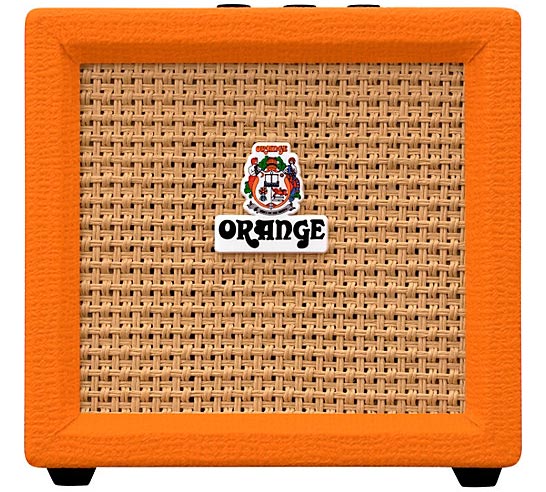
| Estimated Price | $70 |
| Type | Solid State |
| Power | 3W |
| Speaker Size | 1 x 4″ woofer |
| Features | Built-in Chromatic Tuner |
| EQ | Shape Control |
| Inputs | 1 x 1/4″ (instrument), 1 x 1/8″ (aux in) |
| Headphones | 1 x 1/4″ (8-ohm speaker) |
| Power Source | 9V Battery or 9V AC Adapter |
My Review: The Orange Micro crush pix3 is an amp from a long line of great amps that give players a feeling of power, no different from the Pix3. Even though this small 3W amp an extremely powerful speaker giving players power with portability, this amp gives players the ability to fit into any genre they choose and not worry about the kind of sound their amp is putting out. The biggest issue I faced with this amp out of the box was a lack of a power source, as a battery or AC adapter is not included out of the box, which can be kind of a bummer if you are not expecting that when you open it up.
The Micro Crush has dials for tone and volume control, as well as an overdrive button for that all-important crunch. That is all the control you get regarding sound. There is also a built-in tuner that can be switched on and off at the press of a button; There are two jacks; a 1/4 “input jack for your guitar and a 3/8 “output jack for your headphones should you choose to use them. However, you do not have to use headphones because the Orange Micro Crush has a deceptively powerful 4” speaker that can kick out quite a bit of noise for a small thing. The PIX3 can be powered by either an external 9V (500mA) power supply or a standard 9V battery, adding an extra degree of portability to this tiny package. Though, as mentioned above, you will have to buy your power supply separately.
As I have come to expect out of orange amplifiers, the Micro Crush PIX3 offers a beautifully crisp, clean tone when played through the clean channel and provides a warm, distorted tone when played through the overdrive channel. This gives the PIX3 that admirably crunchy tone you want to hear from an orange amplifier. Unfortunately, due to the amp’s size, the bass response is a bit lacking and is somewhat thin due to limitations and the amp’s size. All in all, I have to say that this amp is great for all players who want portability and great tone in one small box. This is easily one of the best battery powered guitar amps available.
12. Fender Mini Deluxe
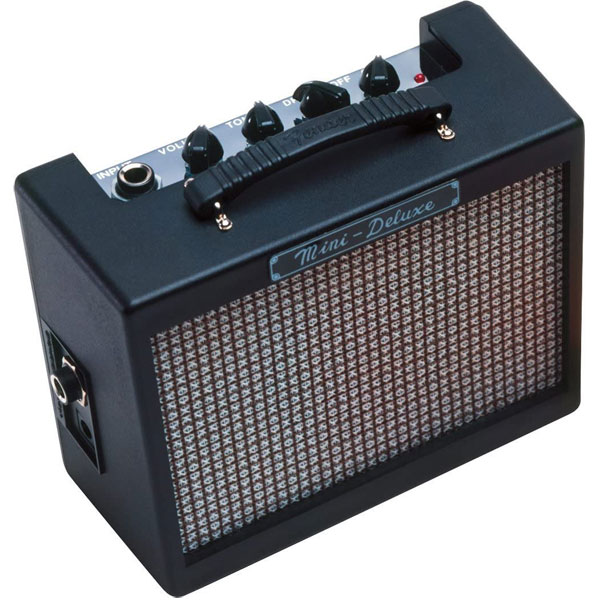
| Estimated Price | $34 |
| Type | Solid State |
| Power | 1W |
| Speaker Size | 1 x 8″ |
| Effects | Overdrive |
| EQ | 1-Band |
| Inputs | 1 x ¼” |
| Headphones | 1 x ¼” out |
| Power Source | 1 9V battery or AC power adapter |
My Review: Much like the Fender Tonemaster Mini mentioned previously on this list, The Fender Mini Deluxe a sized-down version of the Fender Hot-Rod Deluxe. The Mini Deluxe has a tweed outer covering and slick-looking chicken head knobs that screams vintage. This small amp is powered by one single 9V battery and has a single eight-inch 1W speaker, which for its size can put out a decent bit of sound. At only six inches tall and weighing about a pound, this amp is extremely easy to carry around with you.
The Mini Deluxe is a small amp; that being said, it only offers the essentials when it comes to controls. On the top of the amp, you will notice that you have four control knobs for power (comes as a knob, surprisingly), volume, tone, and drive. Instead of an EQ section, you get a tone knob that acts as a single band EQ that offers quite a bit of range. Although it has a fairly limited design, The Fender Mini Deluxe offers a decent amount of versatility.
When putting this up next to a full-size Fender Hot Rod Deluxe, you are going to notice that by comparison, the Mini Deluxe does not sound nearly as good as the full-size amp. But, for what it is, the Fender Mini Deluxe offers a great sound that many battery powered amps could only hope for, and with only a 1W speaker, that is quite the feat. The clean tone is pretty decent, with a good amount of clarity. The overdrive offers a pretty nice, crunchy sound that offers quite a bit of options when adjusting the drive to give yourself the overdrive sound you are looking for. Messing with the tone knob offers quite a bit of variety to the color of your sound, which is pretty surprising for an amp of this size.
While there are many options on the market, even a few from Fender, it is still one of the best microamps on the market today, giving players enough versatility to make it worthwhile for practice sessions and small jam sessions.
13. Roland Micro Cube GX
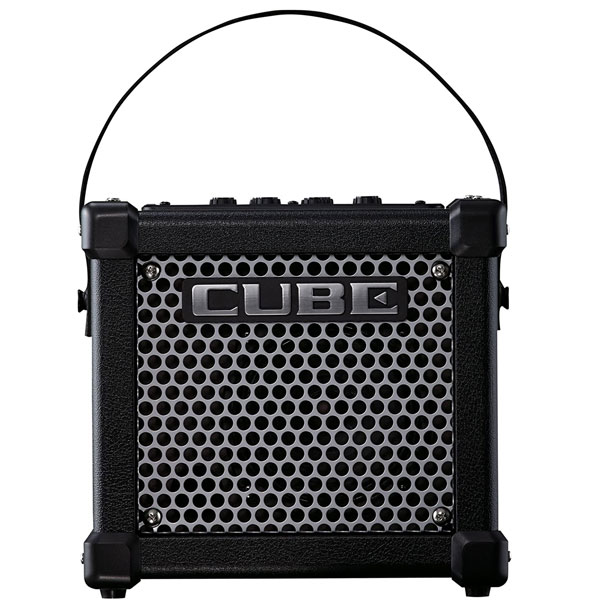
| Estimated Price | $160 |
| Type | Solid State |
| Power | 3W |
| Speaker Size | 1×5″ |
| Effects | Chorus, Flanger, Phaser, Tremolo, Octave |
| EQ | 1-Band |
| Inputs | 1 x 1/4″, 1 x 1/8″ (aux in) |
| Headphones | 1 x 1/8″ |
| Power Source | 6 AAA Batteries or Included AC Adapter |
My Review: The Roland Micro Cube GX is a classic amp that did not have much competition when it first came to the market. As the years went on and more micro portable amps became more readily available, Roland needed to step up its game to keep itself among the best. As Roland started to make changes to their MicroCube line of amps, I was intrigued to see what quality of life improvements they might decide to throw in.
Coming in with a five-inch 3W speaker, the Micro Cube runs on 6 AA-size batteries, offering up 25 hours off a single set of batteries. This model is an upgrade from previous versions of this amp, as the previous models only offered 2W speakers. While this may seem like a minuscule difference, by comparison, it makes a pretty noticeable difference. This watt upgrade gives a little bit of a boost to sound output.
The Micro Cube GX offers eight switchable amp types with separate gain, volume, tone, and master volume controls. The Modelled sounds range from clean, blues, classic rock, and even extreme heavy metal amps settings, giving a lot of variety in a ridiculously small package. Something great that Roland added to the version of the Micro Cube is the ability to store your favorite sound settings with just the push of a button. The only issue that comes with storing your favorite setting is the fact that you can only store one setting. The iCube Link interface jack integrates with the iPhone, iPad, or iPod Touch, providing two-way communication with your music apps. Not only does this allow you to play along with music tracks, but you can also send the modeled amp sounds into an iOS recording app.
The amp’s sound seems weightier than that of the original, and there is a slightly compressed feel to the cleaner tones that make them sound more ‘produced.’ Those blues and rock sounds come over well too, and with a surprising impression of power and depth. The sound gets a touch rough at high volumes but used sensibly, it actually sounds really good, and it’s certainly not a toy. For busking, or open mic nights, the MicroCube GX delivers the goods in style
While Roland has gained some more competition since the release of their first Micro Cube model, they have added plenty of extra features and quality of life improvements to keep it in high regard with players.
14. Pignose HOG-30 (Best for Bass)
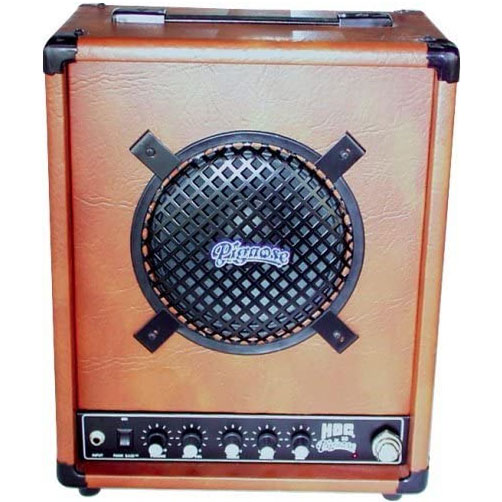
| Estimated Price | $270 |
| Type | Solid State |
| Power | 30W |
| Speaker Size | 1 x 8″ |
| Effects | Overdrive |
| EQ | 3-Band |
| Inputs | 1 x 1/4” |
| Headphones | 1x ¼” |
| Power Source | Internal rechargeable Battery |
My Review: Another amp with acoustic guitars in mind, the HOG-30 by Pignose, allows players to have a massive portable amp with a great rechargeable battery. Not only is the HOG-30 geared towards acoustic guitars, but it also works great for basses and keyboards as well. The Hog 30 is rocking a massive 30W 8″ speaker giving players enough power to get you through any practice session or a small gig. The HOG-30 comes with internal rechargeable batteries that boast a six to ten-hour lifespan allowing plays to have long practice sessions without worrying about running out of power mid-jam.
This amp has an intense power to its sound, granted. It might not be as big as some of the other bass/keyboard amps you see on the market today, but the volume and sound output are phenomenal. The amp itself has a volume, master volume, and of course, treble, mid, and bass settings, giving players the chance to adjust their sound to give them exactly what they are looking for. This amp also includes a pretty neat effect option by pressing the funk bass switch. This option gives players a pretty decent amount of distortion that adds another level of depth to the sound players are able to make for themselves.
The HOG-30 is a great choice for players looking to set up a small jam session that blends well with other amps with plenty of options and great battery life, and it is definitely worth a look.
15. Roland Cube Street (Best Busking Amp)
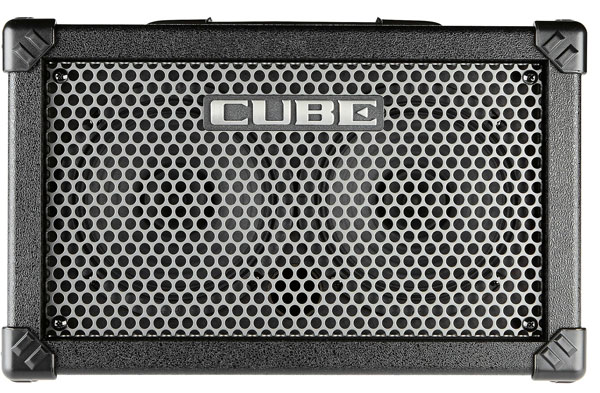
| Estimated Price | $300 |
| Type | Solid State |
| Power | 5W |
| Speaker Size | 2 x 6.5” |
| Effects | Reverb |
| EQ | 3-Band |
| Inputs | 1 x 1/4″, 1 x XLR-1/4″ combo 1 x 1/8″ (aux) |
| Headphones | 1 x 1/4″ |
| Power Source | 6 AA Batteries or Included DC Power Supply Adapter |
My Review: While expensive amplifiers are the dream of many guitarists, it is not always practical for everyone. If an amp that is designed for home, street, or stage is what you are after, then the Roland Cube Street is the perfect option for you. With a rugged design that makes it great for portable use, whether outside busking on the street or performing on stage, the Cube Street has all the power and tone you could want.
While the Cube Street controls are a bit extensive, they are segregated and very straightforward to use. The controls sit at the top of the amp for easy access. On the guitar channel, there are EQ controls for bass, middle, and treble, as well as rotary controls for the effects, delay, and reverb. In addition, the amp also includes different amp model settings to allow players to find the right sound to fit their style. The control panel’s left side is a section dedicated to mic controls, including 2-band EQ for bass and treble, with delay, reverb, and volume. The controls might be a bit overwhelming at first, but I have to say that that solid, responsive, and very easy to understand after getting some time to learn them.
While this might be a small amp, the Cube Street offers players many really useful features. Starting with the basics, this amp is voiced by two high-performance 6.5-inch speakers with 5W of power. The Cube Street also comes in a stylish black case with a silver grille that looks pretty great for an amp at this price point. The Cube Street also works out very well as an amp for busking with amazing 15-hour battery life, lets street performers go out and play without worrying about running out of juice mid-set.
There is plenty of tone coming from this small amp that is helped by the eight amp models and EQ controls. The Cube Street gives players a range of options, from warm, mellow, clean tones to intense high-gain distortion for heavy rock and metal. The range of effects is not vast, but what is included is enough for good sound shaping. It may not be the loudest amp in this price range; it certainly fills a huge space.
While you may be able to find more powerful and more versatile amps at this price point, the overall package Roland offers with the Cube Street supersedes anything else you could find. Although this amp is intended for players on the go, the Cube Street proves to be a reliable great sounding amp that will serve you for years to come.
Choosing the Right Battery Powered Guitar Amp (Buying Guide)
The First step in choosing your amp is to know what you plan on using it for. Are you planning on using it for acoustic or electric? Bass or Keyboard? What is your playing style, or what genre of music do you plan on playing? All of these questions are very important when making this decision.
However, those with a preference for only a small amount of tuning would be better with a brand that’s geared for requiring the least amount of equalizing as possible.
Additionally, where do you intend to play? Maybe you’re a beginner that wants something to jam out within your backyard or bedroom.
For that, you should consider getting one that has either AC or DC lines that you can plug into an electrical outlet. If you travel, it’s about how well the amp sounds without adapters, along with the size and weight of the device.
Types of Batteries Used in Amps
While some amps use an internal battery that is recharged, some use replaceable batteries. It is important to optimize which ones you use as not to have to replace them constantly. Whether it’s 9 volts, AAA, or AA, you can find them around. Just ensure that the amplifier you’re buying them for can handle the rechargeable brands. Also, ensure that you’ll need them! Those with sole reliance on battery power, try only to use good, reliable batteries that won’t lose power too early in your playing. To cut back on the amount that you’ll end up spending for the duration that you have the amp, stick to rechargeable, then normal as an alternative.
Busking: Busking, which involves playing musical instruments of all kinds in an outdoor setting, is where battery powered guitars shine. Anyone that has or anticipates taking part in such activities should factor in the predicted crowd size and the level of ambient background noise before buying such an amp. The larger the gathering, the better off you would be with portable amps but larger than the average. It is always important to make sure the amp you plan on buying can put out enough sound outdoors to make it worth buying. If you do not, it could just be a waste of money for you down the line.
Battery Powered vs Full-Size Amps
In most cases, these amps are incredibly small compared to the full-size amps you normally see being used for gigs, and in that respect, you need to understand that these amps do not recreate that same sound you would normally get. When choosing your amp, you need to go into it with the idea that you need to judge the tone based on the amp you are playing on. There are always the brands that sound similar with or without AC power, but those will diminish sound quality as you play with it on battery power for a while. It’s almost the same as using wireless Bluetooth speakers, whereby the volume is lowered as the battery drains away until it turns off completely.
Hopefully, this guide helps you make an informed decision on the amp you choose and gives a rough idea of what reputable brands are the best to go with. Good Luck and happy playing!

My name is Chris and I’ve had a passion for music and guitars for as long as I can remember. I started this website with some of my friends who are musicians, music teachers, gear heads, and music enthusiasts so we could provide high-quality guitar and music-related content.
I’ve been playing guitar since I was 13 years old and am an avid collector. Amps, pedals, guitars, bass, drums, microphones, studio, and recording gear, I love it all.
I was born and raised in Western Pennsylvania. My background is in Electrical Engineering, earning a Bachelor’s degree from Youngstown State University. With my engineering experience, I’ve developed as a designer of guitar amplifiers and effects. A true passion of mine, I’ve designed, built, and repaired a wide range of guitar amps and electronics. Here at the Guitar Lobby, our aim is to share our passion for Music and gear with the rest of the music community.

Why, in the third decade of the 21st century, do all of these “cutting edge technology” manufacturers still think alkaline batteries (or best case, proprietary chargers) are a thing? Three words: U. S. B. …Anybody?
The spark mini the new king of the hill.. usb c recharging. Tiny. Excellent